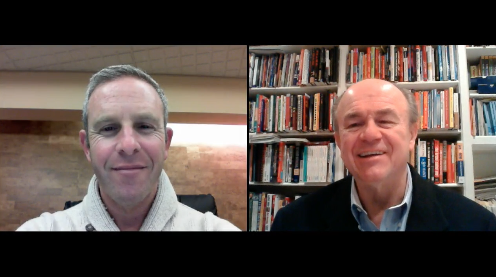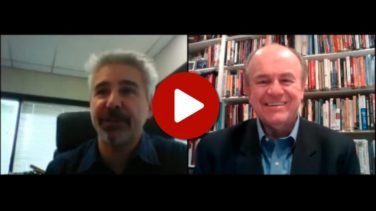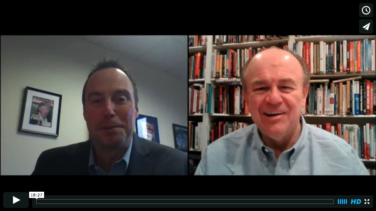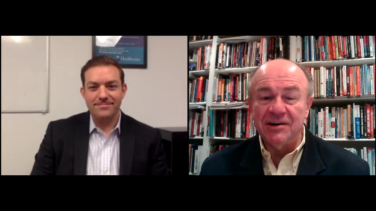The days of paying millions of dollars to celebrities to serve as spokespeople for your brand may be coming to an end. A recent report from McKinsey revealed that customers are twice as likely to switch to a new brand because of an everyday person’s recommendation rather than a celebrity’s endorsement. That is why more and more brands are turning to influencer marketing, in which bloggers, vloggers or advocates who have a lot of pull within their communities are being approached by brands with information—not money. A trend that David Zaritsky, President, PulseCX, believes will become table stakes in pharma in just three to six months. David explains how to find these influencers for pharma brands and the keys to successfully implementing influencer marketing. He also provides a few case studies that demonstrate what past pharma companies have done wrong in this area and how others have succeeded. Contact David at dzaritsky@pulsecx.com to learn more.
Transcript:
Bud Bilanich: Hi folks, Bud Bilanich here with David Zaritsky. And we’re talking today, doing another version of Experts on Call interviews. David is the President of a company called PulseCX, a healthcare marketing company. And their tagline is: “Creating the ultimate customer experience.” And as I understand it David that’s where the CX comes from—CX stands for Customer Experience?
David Zaritsky: Yeah it is. It stands for Customer Experiences yes.
Bud Bilanich: All right. So anyway what we wanted to talk about today is influencer marketing. And I guess you guys are working on this whole area here and it’s part of creating the ultimate customer experience. And so can you tell us a little bit about what influencer marketing actually is.
David Zaritsky: Yeah no it’s a great question because I think to different industries and different verticals it means different things. So the best way to describe what it is I think is to really kind of give an analogy. And way back when they used to pay Joe Namath $40 million to be a spokesperson for a brand. And people would look at Joe Namath and if they were a fan they would connect to the brand or they wouldn’t. Now with social media what they’re doing is they’re connecting with everyday individuals: Moms, millennials, your everyday Joe, who’s online who basically has an influence.
What does that mean? So the best equation to give is: An influence is somebody who has a particular audience reach. And you multiply that by the brand affinity, how close they are to the brand itself, also multiplied by the relationship with the amount of people that they can influence. So influencer marketing takes a very small group of individuals that—for want of a better word—they’re key opinion leaders around your brand or around your vertical.
And instead of paying Joe Namath $40 million they may give this person virtual tools. Or they may give them $10,000. But this person has a broader reach. They have a more authentic reach because they know they’re not being paid for their influence or their opinion about a brand. They really, truly believe and it’s very authentic. It’s very real. And I would tell you McKinsey just came out with a report that’s very interesting.
But McKinsey is saying that influencer marketing—using the everyday individual who has this hold on these individuals, who has this influencer—is becoming rapidly the wave of the future to the point where influencer marketing has twice the likelihood of somebody turning over from one brand to another if they’re influenced by a key opinion leader as opposed to a celebrity like Angelina Jolie or Brad Pitt or somebody like that. It’s pretty interesting.
Bud Bilanich: That’s absolutely fascinating because a) I think it creates an opportunity to be a little more cost effective in how you’re doing your marketing, and b) there’s this sense of authenticity as opposed to having a celebrity spokesperson.
David Zaritsky: Absolutely, absolutely. And that’s what I think people are grappling with right now especially in the pharmaceutical industry is, “Well that’s great you know for celiac and gluten products and things like that, and Cheerios and Coca-Cola and Starbucks. But how do we do it in the pharma space.” And to be quite frank the algorithm doesn’t change. You still have people in certain disease states like hemophilia for example.
With hemophilia it’s a very small community. And there are about three or four bloggers and vloggers who are very popular. So the very smart pharma companies are saying, “Why don’t we engage with those three or four people that we may have some positive influence on. Give them the tools that they need to create an authentic moment with our brand. And instead of the pharma brand focusing on features and benefits let’s let them create the customer experiences.” And it’s working very well.
Bud Bilanich: So these folks aren’t necessarily physicians?
David Zaritsky: No. No, in fact very often they’re not physicians. They’re often patients. They’re often individuals that have tried the brand. Or they’ve tried multiple brands and had failure. And they want to share their stories. So the interesting thing with influencer marketing I think there’s a misunderstanding out there that these influencers are being—I’m not going to sugar coat it—bribed by the brand: Given things, trips, and money.
Very often all they’re given is information and education to share out. And by helping them become more of an expert around the brand these people are becoming more influential.
Bud Bilanich: That’s really interesting. And I think that it’s really true because I do some blogging myself about careers and my motivation really is to help other folks—younger folks in particular—be able to build careers. And so I’m assuming that people who have had very positive outcomes with some sort of a product oftentimes become evangelists for that product. And they’re happy to just help other people. They don’t necessarily want a lot in return.
David Zaritsky: That’s right.
Bud Bilanich: The doing itself is almost enough for them.
David Zaritsky: That’s absolutely correct.
Bud Bilanich: That’s terrific. So do you have any good examples of how companies are successfully using influencer marketing today?
David Zaritsky: Yeah I think in the hemophilia market like I was talking about before it’s a situation with a lot of these patients; they’re very distrustful of pharma. They’ve gone through all the plasma stages. They’ve gone through lots of overpromising and under-delivering unfortunately with many of these brands. So what’s happened is in the hemophilia community they’re very watchful. They filter all of this information.
However if you get some of the advocacy leaders of the hemophilia community or two or three of the bloggers who are trusted entities they’re very authentic. What they’re asking for of the brands is: Just give me information so I can draw my own conclusions and I can share it out. So it takes the influencers along a hero journey because the influencer just wants to have that authenticity. But they also want to be seen as an expert. So what can you provide them as a brand that’s going to help all ships rise?
So hemophilia is a great example of where they’re doing this the right way.
Bud Bilanich: Well I think one of the things that’s interesting David is you used the word community a couple times there when you were just speaking. And that’s one of the things I guess that social media has created the opportunity for—for people to come together around whatever, whether it’s a disease that they’re struggling with, or any other kind of thing. And that with the community being there obviously certain people seem to become influential in those communities.
And the idea is not to take advantage of but to be able to best utilize these people who are influential.
David Zaritsky: That’s right. And it’s a win-win situation because the influencers are constantly looking for that next nugget that they can share out because it’s not an unlimited pool of information. So if the company—if the brand can provide that information—or I’ll give you another example of where this worked really well with hepatitis B. In the hepatitis B community what they did with these influencers—and there were about three or four of them across the nation—they basically asked them to raise their hand and said would you like—would it be helpful for you and your readers, because they’re all bloggers, to receive information ahead of the press, ahead of the media that might be informational on what are we doing to further the advances of research of hemophilia? And of course everybody’s hand rose up. They wanted to be in on this because it’s really created for us and by us. And so it was a new tool for the advocates and the evangelists as you put it—which I love how you put it.
The influencer marketers had what they needed from a toolbox standpoint and the brands won because they were getting their message out in a very authentic way. It serves all purposes.
Bud Bilanich: Yeah I think—I mean this is very cool. I’m assuming though like any good idea it doesn’t come without some potential problems. [laughter]
David Zaritsky: Absolutely.
Bud Bilanich: So what are the kinds of potential issues that you see if a company’s interested in trying to go this route?
David Zaritsky: So many. First of all, probably the biggest one—just stepping back a few steps—is influencer marketing has the potential, the unfortunate potential, of becoming the new, hot thing. So if you remember social media was there not too long ago. Customer experience was there not too long ago. Influencer marketing, everybody’s saying, “Oh we need to get a millennial person because that’s intuitive. And we need something on Facebook.” That’s a thing.
Influencer marketing is an experience. It really is. Quite frankly it’s not a channel. It’s not online or offline. But it’s an experience where small groups of individuals can influence others with an authentic methodology. But what’s happening is a lot of companies are just wrapping themselves around of a channel or a thing. I’ll give you a perfect example. A large pharma company wanted to do influencer marketing. They got all of their marketing people around.
And what came out of that was a new iPad tool—interesting. How does an iPad tool factor into all that? Well it didn’t but they were looking for the next shiny penny for want of a better term. Influencer marketing has to be adopted at every level of an organization. And you really need to have the vision of why you want to have influencer marketing to begin with or you will trip.
Bud Bilanich: Well you know that’s very interesting. Let me give you an analogous situation to this. I do a lot of organization effectiveness consulting. A lot of it is around organizational culture. And so often one of my clients will say, “Well we want to create a Google culture. We want to bring in some beer kegs or ping pong tables or pool tables or bean bag chairs.” And the point that I try to make with them is it’s not the accoutrements.
It’s the culture that they literally set out to create at successful companies like Google or Facebook. And some of this other stuff came along as a part of it. So merely having kind of like a cool office—
David Zaritsky: Right.
Bud Bilanich: doesn’t necessarily mean that you’re going to have the kind of culture that you want, Particularly I’ve seen some of these companies be almost sort of draconian in the way they treat their employees but they have a cool looking office.
David Zaritsky: Yeah.
Bud Bilanich: And I think that’s the kind of thing that you’re talking about here.
David Zaritsky: It is. And you know something? I’m going to absolutely lower the shields for a moment because we were there as a company. So PulseCX is very similar. Our offices are—you wouldn’t know it by the background here—but they’re very cool. We have dogs running around. We have a bar in the back. You know we have props and toys everywhere. The reality is when we did a customer employee survey the number one thing that everybody loved about our culture had nothing to do with—like you said—the accoutrements. It had the fact that senior management here empowered their people to make decisions.
Bud Bilanich: Mm-hmm.
David Zaritsky: That was it. That was number one. All the dogs and everything like that were number seven, number eight, and number nine. And so to that point you’ve really got to dig. And you almost have to do a customer experience audit of why you’re doing influencer marketing. Why do you want a ping pong table? Is it significant? Is it making a difference? Or are you just trying to be that new, hip company on the street?
Bud Bilanich: Yeah and I think that goes to the whole notion of what you were talking about—creating a new iPad app. Yeah it was kind of cool but I mean I think that what seems to be missing—and I think—I want to kind of go back to what you had said.
David Zaritsky: Mm-hmm.
Bud Bilanich: It has to be something that’s kind of top to bottom, through the organization. This is how we do business. This is how we think about interacting with patients and customers as opposed to like an add-on.
David Zaritsky: Yes.
Bud Bilanich: And I think that’s the main—that’s kind of what I was taking from what I was hearing you saying as potential problems.
David Zaritsky: Absolutely. So the easy way to think about it is there are three things that need to be in place for influencer marketing. If there are two out of the three I wouldn’t even do it. But number one is senior leadership acceptance or buy-in or approval or better yet sponsorship. Have the senior leadership of your company say: We are going to do this. But the next thing that goes hand in hand with that is the why. You have to answer the why.
And a lot of companies are going back and saying influencer marketing the way it’s defined; does it ladder up to our strategic imperatives? Does it really match our vision? And which strategic imperatives will it check off? And then the third thing is you really need to commit and be dedicated to it. Creating a channel online or doing a pilot program where you engage a vlogger or a blogger is actually more dangerous than not doing it at all. And I’ll tell you why—case study.
A company on the West Coast—I will not name them—decided to do influencer marketing this past year. And they got three or four vloggers together. And they gave them a bunch of tools. And after about three months they said, “You know what? It’s not what we expected. Let’s just drop it.” Well by dropping them cold the vloggers felt like they were left out in the wind. And so they went to town on the company. And they became anti-coaches, and anti-evangelists.
And you cannot let these—it’s like adopting a puppy. You can’t after the puppy is not cute anymore put them out on the street. That’s just wrong. So you can’t do this with bloggers and vloggers because they’re so powerful that you want to keep that positive momentum so it’s a long-term commitment.
Bud Bilanich: Yeah and some of that is just common sense. You engage with somebody; you need to treat them as just a fellow human being.
David Zaritsky: Absolutely.
Bud Bilanich: And to just kind of drop it—even had they decided to drop their program but they had done it in a more open, communicative way it probably wouldn’t have created as big a problem as—
David Zaritsky: Absolutely
Bud Bilanich: probably just getting an email of, “Well we decided not to go this route anymore.”
David Zaritsky: Absolutely. I couldn’t agree with you more.
Bud Bilanich: Yeah. And you know something else that you said that I think is very interesting; you were talking about senior leadership.
David Zaritsky: Mm-hmm.
Bud Bilanich: And you were talking about senior leaders need to be sponsors. And it’s very interesting because again in my consulting work I deal with that a lot in any kind of organizational change. And one of my messages to senior leaders often is there is a big difference between sponsoring and supporting.
David Zaritsky: Sure.
Bud Bilanich: It’s easy to say, “I support these marketers. Go ahead and do it,” and do nothing about it.
David Zaritsky: Right.
Bud Bilanich: So I tell people sponsoring is an active process where supporting is really a passive process.
David Zaritsky: That’s right.
Bud Bilanich: Yeah I support lots of things like world peace. I don’t do a whole lot about it.
David Zaritsky: [laughter]
Bud Bilanich: I maybe write a check every once in a while but I mean if you sponsor something you do have to be actively involved and you need to be able to speak the language. You need to be able to engage with your marketing people as they’re going and maybe even with the influencers as you’re going about trying to make this work in your company.
David Zaritsky: Absolutely. One of the things that we tend to do with influencer marketing—it’s just a matter of habit now—is you build a RACI document: Responsible, Accountable, Consulted, and Informed. And you make sure the senior sponsor is not just consulted or informed. You’re not just sending them emails like, “Here’s where we are in the process.” You give them some accountability. And you consult with them too on their expertise.
So this way everybody feels like they have their fingerprints or their DNA embedded in this influencer marketing. It not only helps to educate them. It helps them to feel a part of the forward motion of this.
Bud Bilanich: Yeah. So one of the other things I wanted to ask you, and we’ve been kind of talking around it, is the idea of sort of best practices if you’re attempting to start an influencer marketing program.
David Zaritsky: Mm-hmm.
Bud Bilanich: Clearly leadership.
David Zaritsky: Leadership is one of them. We probably should start and finish with that. That committed senior sponsor. I love the way you put that as opposed to just supported. The other one is making sure that defining influencer marketing and then socializing that definition internally because it is like the word love. It means different things to different people. And in an organization you don’t want to leave it up to interpretation because it is a new terminology.
So coming up with this is the terminology. This is what we mean. It’s different than social media. It’s different than brand alignment. This is what it is but then following that with the why. It’s got to have the why in there meaning why are we doing this and how does it ladder up to our strategic imperatives? And once we do this what’s the definition of good look like? I’ll never forget. We were talking to a pharmaceutical company and they said, “All right we’re ready. We’re going to take the Starbucks move and we’re going to do a Facebook. And our goal is to get one million likes.”
And we stepped back and we said, “I’m sorry. What is one million likes going to get for you? Do you want more authentic conversations? Do you want deeper conversations? Do you not want conversations because it is pharma?” So you’ve got to really step back and understand why are you doing this? And what does great look like? You want to measure it. It can’t just be a halo effect of, “Hey we’re hip and cool. We’re doing influencer marketing.”
That doesn’t work. How is it going to move the needle, ergo how does it follow back to the strategic imperatives? The other part that I always tell people is the commitment aspect is not just with senior sponsorship, or time, or money. It’s with individuals. You know maybe not so subtle if you are not going to commit to this from a staff standpoint within your organization, make sure you align with a partner who understands influencer marketing, has the time, wherewithal and commitment to do it because it cannot be a quick pilot program.
Bud Bilanich: So somebody like PulseCX.
David Zaritsky: I didn’t say that.
Bud Bilanich: I did.
David Zaritsky: Okay. [laughter]
Bud Bilanich: [laughter] Well that’s why we’re talking about it. That’s the whole purpose of these Expert on Call interviews is we want to talk to people who really can bring new, different ideas not only to the fore but know how to implement them.
David Zaritsky: I appreciate that.
Bud Bilanich: But I mean I do think that you’re absolutely right that just kind of attempting to go down a road and sort of have some vague idea of what you’re trying to do more often than not may create more problems for you than it’ll solve.
David Zaritsky: Yeah exactly. In fact a year or a year and one-half ago when people were starting to climb the mountain of influencer marketing the problem was is that there was so much frustration early on in the pharmaceutical space that they wound up just regressing back to features and benefits. “Oh it’s not quite working. Maybe we can build an app. Maybe the app will show method of action and method of delivery.” And so they went back to what everybody was comfortable with as opposed to—for want of a better term—creating a roadmap of who is going to be taken along this journey and what points everything intersects and ladders up to.
Bud Bilanich: Let me ask you this. What’s the best way to go about finding influencers to do influencer marketing? I’m assuming some would be just web searches. But I’m sure there are more scientific ways of doing this.
David Zaritsky: Yeah. So that’s a great question. There is actually a process around that. It used to be that you would do a web search and look for the ones that have the most followers: A YouTube person, a vlogger, a video blogger. They have one million unique views. They have 10,000 subscribers. They’re the highest within this disease state. That’s a target. It’s actually changed a little bit now. It’s less about how many people are following and more about the brand affinity; meaning is this individual an expert either on your brand or around the disease state that you’re focusing on?
And are they an up-and-comer? So, they may be relatively new but they’re skyrocketing as opposed to somebody that’s getting a little bit stale. And I’ll give you a case study. There’s a gentleman out there called Gluten Dude. And Gluten Dude is an individual who focuses on the celiac community. He’s an advocate for those with celiac. He’s also an advocate against people that are on fad diets that have to do with gluten. “I’m avoiding gluten because it’s better for me,” says Gwyneth Paltrow.
He discounts that and says, “No, no, no. Who are the ones that if they have gluten in their diet they become ill for days? They become incapacitated—all different ages?” Well he had a small following but it was very authentic and it was very growing. Now he’s starting to really explode and he’s probably one of the key individuals to the point where he influenced something with Disney where Disney had a show for kids where they were mocking some child that had a gluten allergy.
And he actually had the episode taken off the air. That’s influence. Now is it influencing a brand? In some cases it is but you wouldn’t be surprised, Cheerios, beer companies, and all these different brands that are now gluten free are canvassing and connecting with Gluten Dude because he’s built this very authentic brand and he’s only on the rise. There are lots of ways to approach it.
Bud Bilanich: Well obviously I mean he’s an advocate. And if he could work this with Disney is advocacy a prime thing in this?
David Zaritsky: It is. It really is. So going back to the hemophilia group you know the advocacy group—something called Blood Brothers—hemophilia. The Blood Brothers group as advocates is very strong but they’ve got two or three members there that are very vocal. They’re very social. That’s the other thing too. You want somebody that’s very empathetic but very social and very vocal, so kind of the wall flowers that post every now and then—not so much.
The gregarious individuals that want to connect and share their stories—sharing is a big thing—those are the ones that people tend to gravitate to.
Bud Bilanich: Well I think it’s absolutely fascinating and I do think it gives everybody who’s watching an opportunity to rethink how they might want to try something that’s the latest, greatest, newest, most shiny thing.
David Zaritsky: Absolutely.
Bud Bilanich: Any last thoughts on influencer marketing?
David Zaritsky: Just that you know we’re taking about this now—you and I. I will tell you this is going to hit a crescendo. I mean a year and one-half ago nobody heard about influencer marketing. Now it’s becoming more prevalent. I would dare say in three to six months it’s going to becoming table stakes. So people as a matter of just like you talk about iPads and just like you talk about Facebook you’ll be talking about influencer marketing. Maybe not so much the sooner you adopt it within your company the better. But the sooner you adopt it in your natural thinking and learning about it—that’s better.
Bud Bilanich: All right. Well that’s great. David thank you so much. It’s always just a delight to chat with you and hear about all the cool things you guys are doing. So again thanks very much. Again folks, David Zaritsky is President of PulseCX. The website is: www.pulsecx.com. Check them out. They’re doing some very cool things. So thanks again David.
David Zaritsky: Thank you Bud, always a pleasure.









